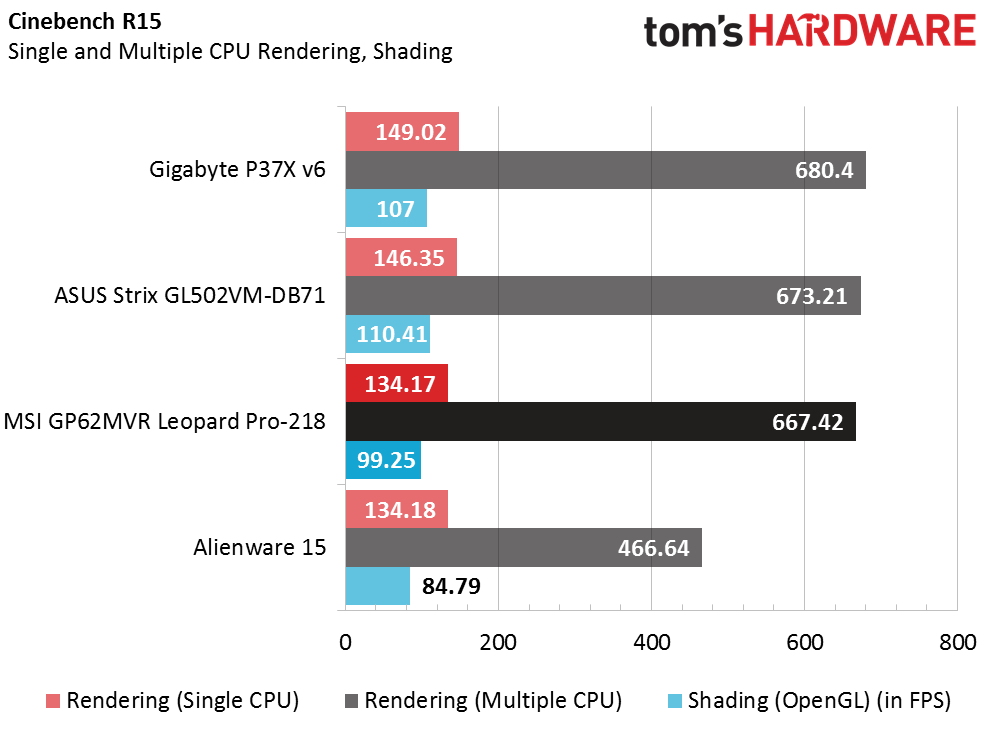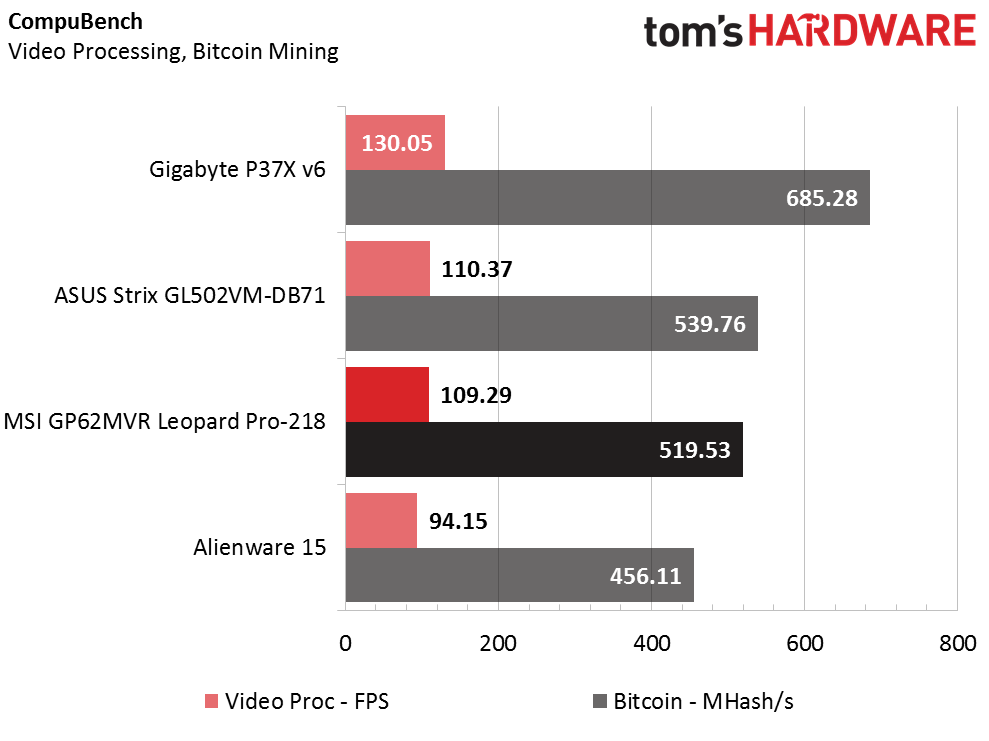MSI GP62MVR Leopard Pro Gaming Laptop Review
Why you can trust Tom's Hardware
Synthetic And Productivity Benchmarks
For our comparison set, we looked to the previously reviewed Gigabyte P37X v6 to observe the difference between the Leopard's GTX 1060 3GB graphics module and the P37's GTX 1070. We also borrowed the testing results from the upcoming Alienware 15 and Asus ROG Strix 15 reviews to see how MSI's offering squares off against similarly configured systems with full-blown GTX 1060 6GB graphics.
The Gigabyte P37X features an Intel Core i7-6700HQ, 16GB of DDR4-2400, a GTX 1070, and a 512GB Samsung SM951 SSD (with a 1TB storage HDD). The Alienware 15 is more conservative with an Intel Core i5-6300HQ processor, 8GB of memory, and a GTX 1060 6GB graphics module. The Asus Strix GL502VM has an i7-6700HQ, 16GB of RAM, a GTX 1060 6GB GPU. Both feature a 1TB 7,200 RPM HDD (as does the Leopard), so the Gigabyte will obviously lead the field in storage-intensive workloads and benchmarks.
3DMark
The MSI GP62MVR Leopard puts up impressive 3DMark Fire Strike scores, besting the Asus Strix and Alienware 15 in the Overall score. The Alienware marginally outperforms the Strix and Leopard in the Graphics test, but it falls behind in the Physics workloads due to its i5-6300HQ processor, which also holds back its Combined and Overall score. The Gigabyte P37X v6 leads the field (and likely will for the remainder of the benchmarks) thanks to its obviously more powerful GPU.
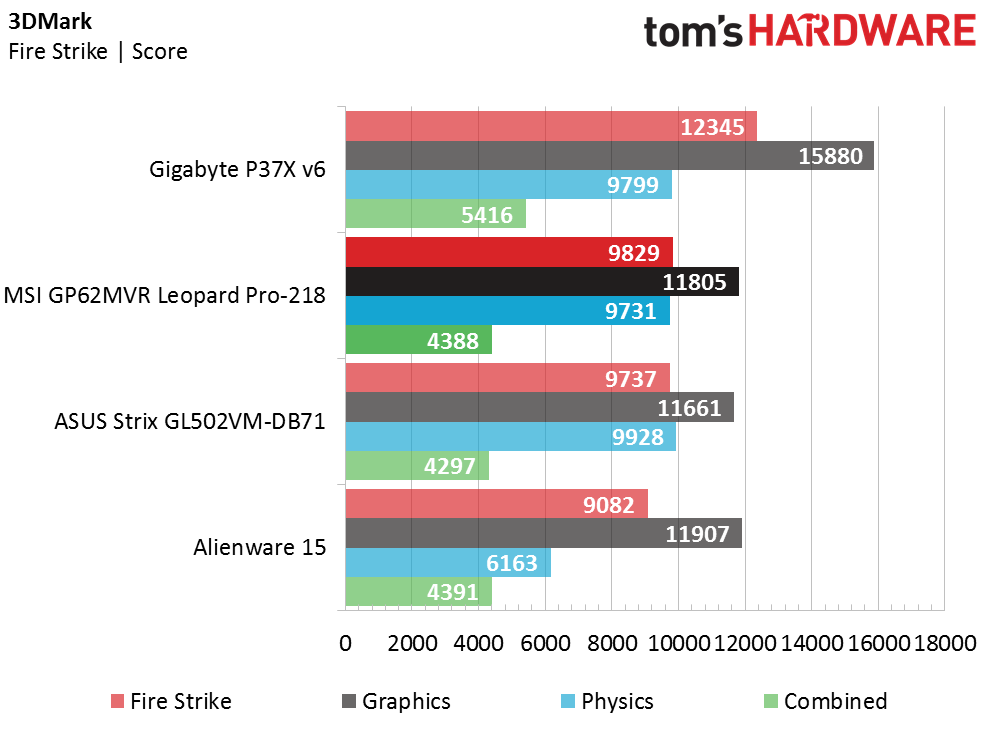
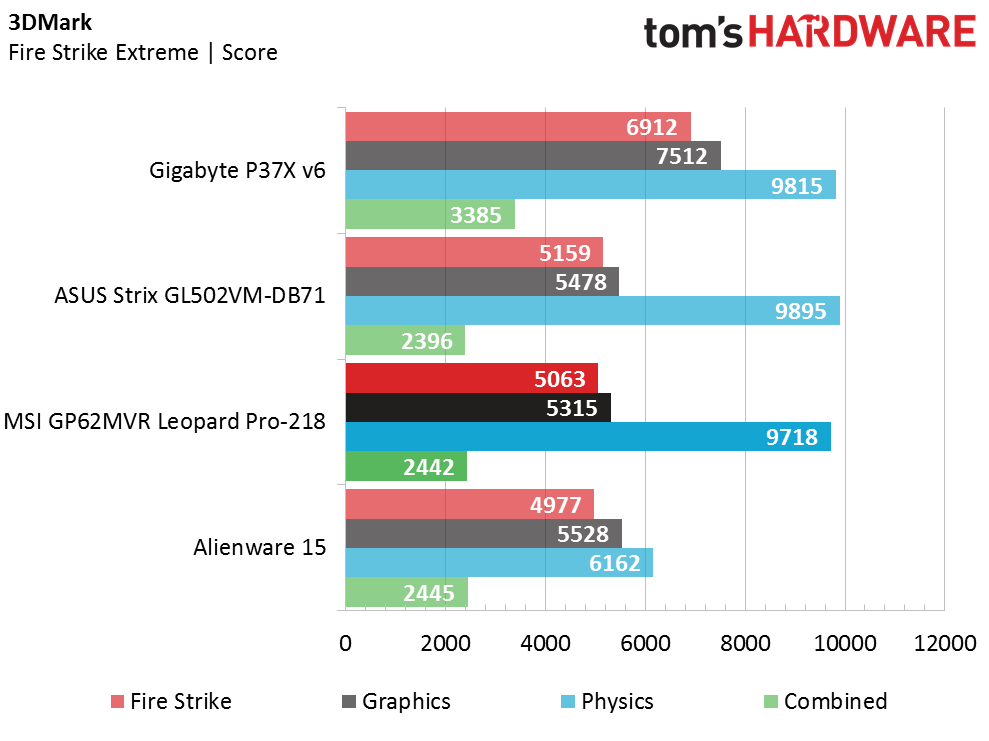
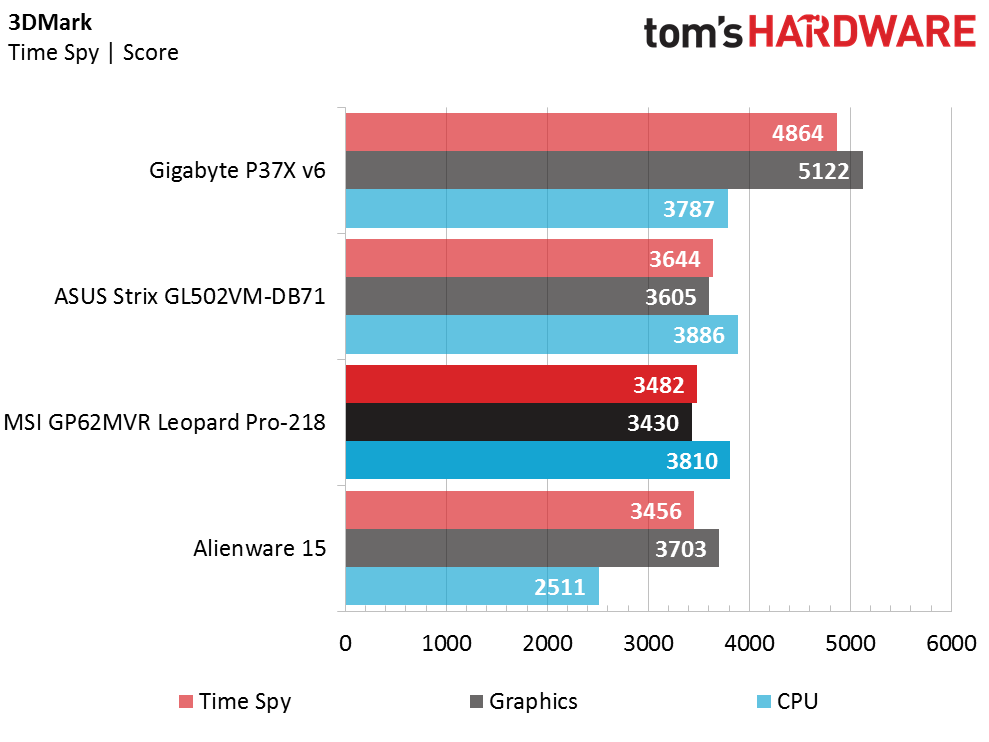
Kicking up the resolution to 2560 x 1440 (Fire Strike Extreme), we can see the Leopard's 3GB GTX 1060 fall behind the Strix, which sports a 6GB version of the GPU. The Physics scores all stay in the same ballpark. The Alienware almost matches the Overall score of the Leopard at this resolution, a testament to the performance trade-off dance these two machines are engaged in (they are the same price with different GPU/CPU/memory configurations). Time Spy produces similar results, with the Leopard falling behind in the Graphics test but narrowly beating the Alienware 15 in the Overall score, thanks to the Leopard's superior CPU.
Cinebench R15
The MSI GP62MVR comes in last in the field here with its single-CPU rendering performance score (by a negligible difference to the Alienware 15), but it bounces back in the multi-threaded test, thanks to Leopard's Core i7-6700HQ (which handily beats the quad-core i5-6300HQ in the Alienware). Surprisingly, the Strix performs better than even the Gigabyte P37X (with a GTX 1070) in the OpenGL shading test. We suspect this could be due to longer boost clock states from more favorable thermal conditions, but we'll dive into that further with the forthcoming review of the Asus Strix.
CompuBench
CompuBench measures your system using three computer vision tests, two physics tests, one graphics test, and one throughput test. We cherry-picked the Video Composition and Bitcoin results to provide video processing and integer performance of the CPU and GPU.
The Leopard beats the Alienware in the Video Composition test (thanks again to the superior CPU) and scores a single FPS less (1.08 FPS to be exact) than the Strix. The Bitcoin results also show a negligible performance difference between the Leopard and the Strix (20.23 MHash/s), which both sport Core i7-6700HQ CPUs and handily beat the Alienware 15. Predictably, the Gigabyte P37X remains at the top of the charts.
Get Tom's Hardware's best news and in-depth reviews, straight to your inbox.
Disk Speed
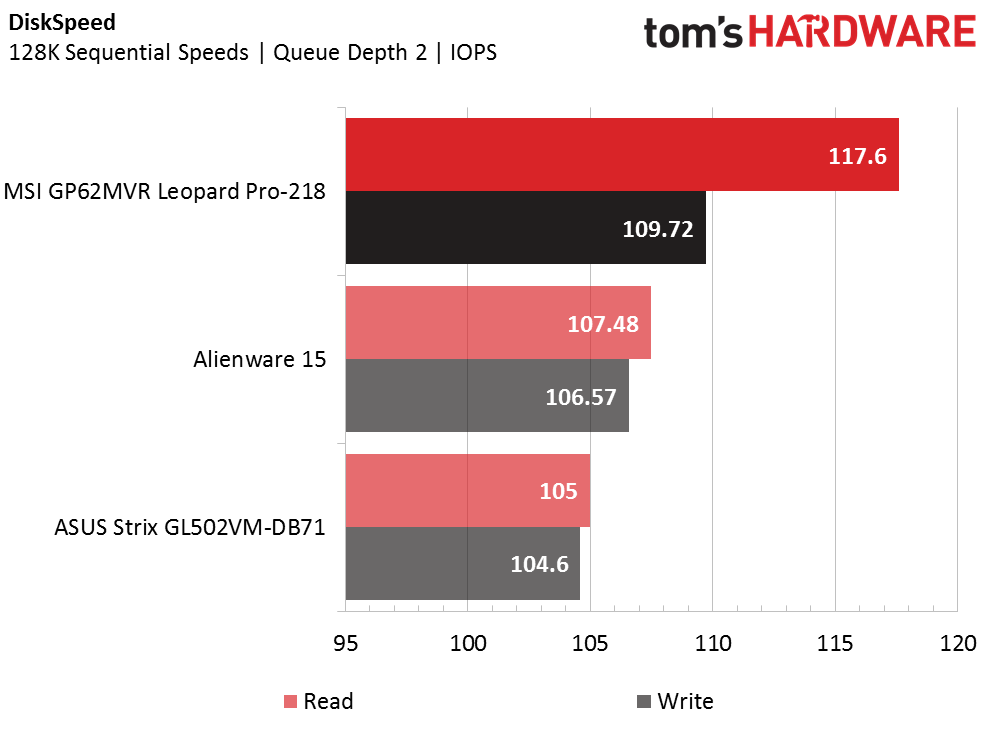
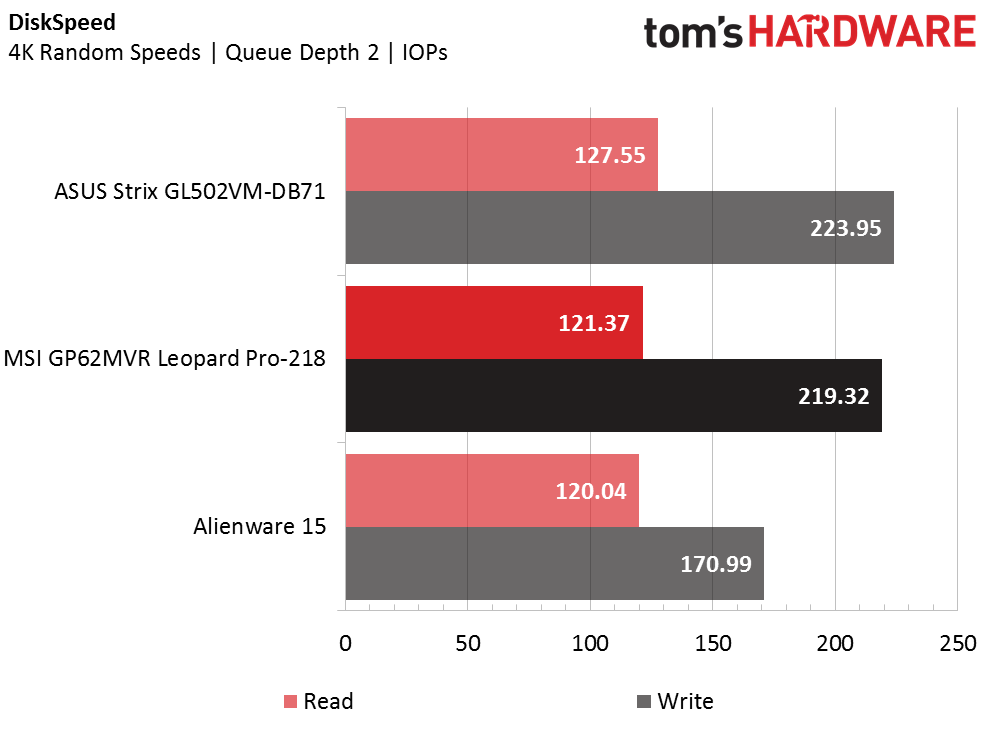
The MSI GP62MVR Leopard Pro's 7,200RPM hard drive performs on par with the other disk drive-equipped systems. The speeds are nothing to write home about, and it's obviously obliterated by the Gigabyte P37X's solid state storage, which we excluded from this chart because of the significant performance difference (with over 10 times the sequential performance of the HDDs, it skewed the charts). The Leopard trades blows with both the Strix and Alienware laptops in the 4K random read/write tests, but it's notably on top of the sequential 128K read/write benchmarks compared to the other laptops with HDDs.
PCMark 8
The PCMark 8 results are close across the board with the Leopard Pro pulling out the win during the Creative tests, even ahead of the Gigabyte P37X, with a GTX 1070. We've researched this anomaly before during our previous reviews, and we even attempted to narrow down the cause by re-running the benchmark and observing the GPU and CPU clock rates of each laptop, but we could not see a discernible advantage from the GTX 1060-equipped laptops that beat out the stronger Gigabyte model. However, the difference in score doesn't equate to huge performance gains, and all of the systems on this chart (with the exception of the Alienware 15) perform in the same ballpark.
Current page: Synthetic And Productivity Benchmarks
Prev Page Introduction And Product Tour Next Page Gaming BenchmarksDerek Forrest was a contributing freelance writer for Tom's Hardware. He covered hardware news and reviews, focusing on gaming desktops and laptops.
-
rhysiam It seems like the GTX 1060 has finally made it possible to release extremely capable 1080P gaming laptops in acceptable (if not ultra-portable) form factors at reasonable prices. Thanks for the review.Reply
One comment: You say, "the Alienware sacrifices CPU power and memory capacity for a better GPU and increased (objectively) aesthetic value"
Surely "aesthetic value" is by its very nature subjective, not objective. Beauty is in the eye of the beholder, after all. -
lunyone Give me a good i5 w/at least the GTX 1060 6 gb GPU and I think we have a more budget friendly option, IMHO. I would like to see how that would stack up and at what price difference we would see.Reply -
FritzEiv Reply18878485 said:Give me a good i5 w/at least the GTX 1060 6 gb GPU and I think we have a more budget friendly option, IMHO. I would like to see how that would stack up and at what price difference we would see.
Hang tight. You're going to see one very soon (literally editing it right now). -
lunyone Reply18878626 said:18878485 said:Give me a good i5 w/at least the GTX 1060 6 gb GPU and I think we have a more budget friendly option, IMHO. I would like to see how that would stack up and at what price difference we would see.
Hang tight. You're going to see one very soon (literally editing it right now).
GREAT! That is the perfect combo, IMHO, for a "Budget" gaming rig, if there is such a thing. -
davea0511b Good review. Still too spendy for me right now, but probably means VR ready will be in the sub $1000 by next year.Reply
FYI regarding this: "the MSI GP62MVR falls oh-so-short of the Alienware 15 (by 0.05 FPS)"... the phrase "oh-so" is generally a diminutive form of "oh-so-much" which means "very" or "extremely", not "oh-so-little" as it seems you intended. I think the phrase you intended was "just-so" or more accurately, "just", as in "just short of". -
Decends I do not understand the point of the 3GB version of the 1060. I wish this laptop came with a 6GB GTX 1060 because i love the minimalist yet nice looking style of the Leopard. It seems i will be forced to buy one of Asus' budget 1060 6GB laptops since MSI has nothing to offer to counter Asus' cheaper options.Reply
